How Long Can I Go Without Taking a Shower
How long tin can y'all go without air?
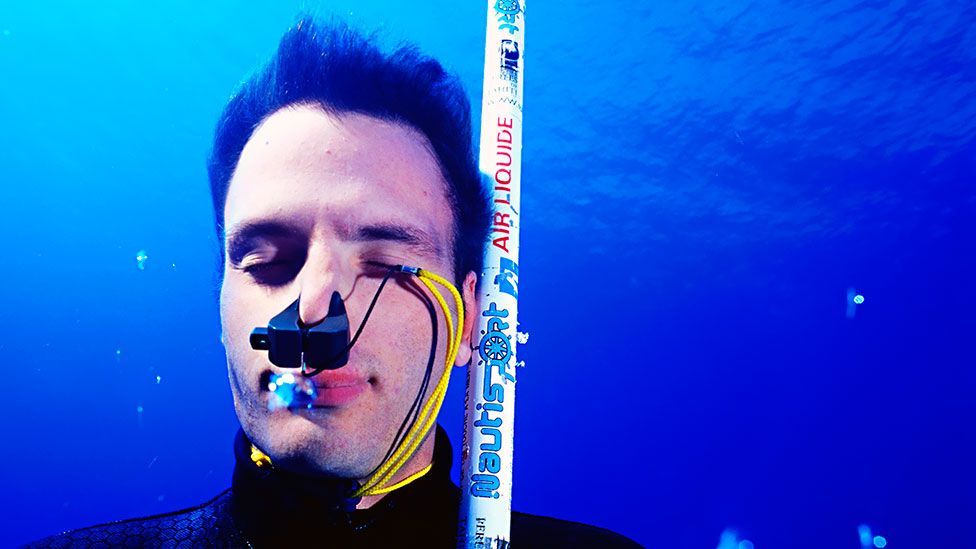
A few people tin hold their breath for an astonishingly long time, discovers Frank Boyfriend. How practise they practice it?
L
Concluding November, 32-yr-old Nicholas Mevoli lay on his back on the bounding main surface, gulping air similar a fish to pack his lungs with air. Then with a minor splash, he dove under the water and began pond downward into the Dean's Blue Pigsty – an underwater cavern in the Commonwealth of the bahamas. Mevoli'south goal was to accomplish a depth of more than than 70 metres (230ft) – and practice it on a single breath of air. It would end in disaster.
How long can someone stay underwater without surfacing? How long can anyone go without breathing? As humans push into our two final frontiers – deep space and the deep ocean – an understanding of our survival in airless environments is worth exploring.
In the emptiness of infinite, unconsciousness approaches very quickly. In 1965, a ruptured spacesuit briefly exposed a worker at Nasa's Johnson Space Facility to an almost complete vacuum in a test chamber. He fainted after about 15 seconds. Contrary to popular conventionalities, he wasn't at take chances from exploding, although at such a low pressure level, exposed body fluids will vaporise at body temperature. His terminal memory before waking again was the saliva boiling away on his natural language.
Freedivers, who swim down to the limit of their ability without scuba equipment, fare better, regularly spending iii minutes or more than underwater. The freediver who holds the record for the deepest dive, Herbert Nitch, plunged to 214 metres (702ft) on a specially-designed submersible, remaining under the surface for iv and a one-half minutes. Freedivers benefit from a physical reaction known as the 'mammalian swoop reflex', which slows the center when the body plunges underwater. (Even submerging the face in cold h2o is plenty to trigger this effect.)
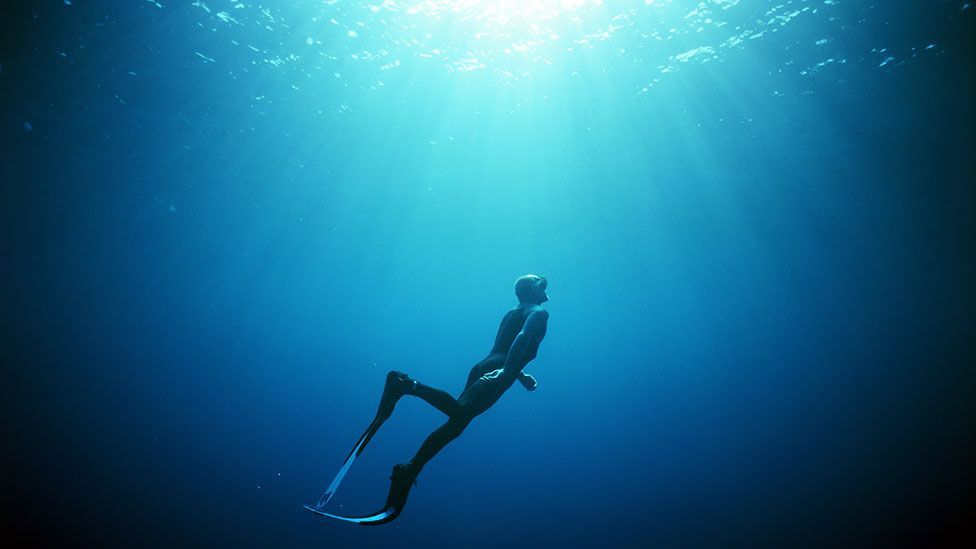
A freediver returns to the surface through rays of sunlight (Scientific discipline Photo Library)
Just although these dives are incredible for their crushing depths, nosotros can final much longer in less extreme circumstances. Wallowing in the shallows of a London swimming pool, Danish freediver Stig Severinsen managed to concur his breath for 22 minutes in 2012, setting a world record that has yet to be browbeaten. How the professionals manage this, when average humans struggle to hold their breath for more than a minute, comes down to preparation, training, and physiology.
Before his record attempt, Severinsen spent near 20 minutes hyperventilating with pure oxygen. This allowed his body to get saturated with oxygen, and also helped scrub his lungs of carbon dioxide. Both are important for long-term jiff belongings. While anybody knows that a lack of oxygen tin be fatal, a build upwardly of carbon dioxide tin can exist equally dangerous. Without the ability to excrete this waste through our lungs, the steady build upward of carbon dioxide in our claret volition plough information technology into an acidic mash. Muscle spasms and disorientation follow, besides as a racing heart and ultimately, death.
Trained freedivers and champion breath holders are likely to take congenital up physical adaptations that assist them go long periods without animate. A study of Brazilian fishermen found those who dived for prey had significantly larger lungs than colleagues who typically stayed in a higher place the surface. The famed Korean and Japanese pearl divers, meanwhile, were shown to overflowing their body with an extra ten% of crimson claret cells during their dives.
Upper limits
The limit of jiff belongings is dictated by how little oxygen and how much carbon dioxide you can tolerate in your body. Both of those, notwithstanding, are governed in turn by your metabolic rate. A diver swimming through the ocean will apply up oxygen and produce carbon dioxide faster than one lying motionless in the water. Freedivers often speak of the need for a meditative mindset in their sport – slowing their heart and emptying their heed to enter a state of deep relaxation. There are other ways to suppress metabolic activity. When Us toddler Michelle Funk fell into an icy stream in 1986, she survived an estimated 66 minutes underwater, preserved by deep hypothermia that reduced her metabolic rate to nigh nothing.
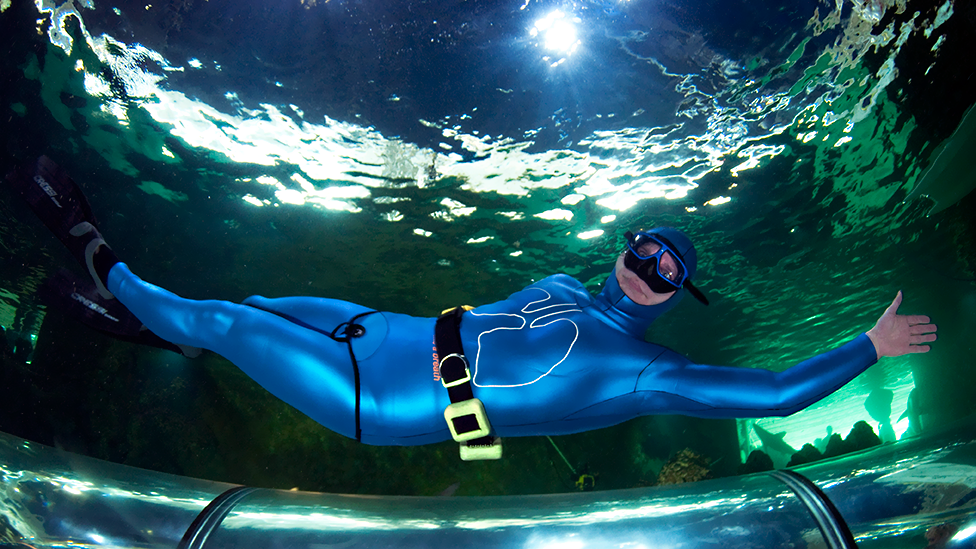
In 2012, Stig Severinson broke the world tape for breath-belongings (without pond) with a fourth dimension of 22 minutes (Morten Bjoern Larsen/AP Photo/Polfoto)
The undisputed champions of everyday breath holding, nevertheless, are diving mammals such equally whales and seals. They can remain underwater for an hour at a time before surfacing. Also as a higher tolerance for carbon dioxide in their bodies, these creatures have muscle tissue rich in myoglobin, which traps oxygen and releases it during long dives. Myoglobin, the protein that lends meat its red colour, is so densely packed in whales that their flesh appears black.
Unfortunately, even the best training won't let yous to mimic the physical adaptations of whales. So are there any alternatives to life without air? Well, yes. You can endeavour angle the rules a little by animate a liquid instead. Not pure liquid oxygen: at -200C, it would turn you into a homo popsicle from the inside out and shatter your lungs the moment you tried to breathe. Instead, fluids that are rich in dissolved oxygen. A course of chemicals known as perfluorocarbons (PFCs) can deliquesce high concentrations of oxygen and carbon dioxide, and are liquid at much more comfortable temperatures. Liquid breathing may sound similar the stuff of science fiction – and indeed, information technology makes its most famous advent in James Cameron's 1989 underwater adventure The Completeness – but it has its roots in successful research.
H2o animate
Perfluorocarbons are bonny because they are colourless, odourless, and not-toxic – much like air – and because they would allow divers to withstand high pressures when escaping from bedridden submarines. Experiments in the 1960s showed that mice and cats submerged in perfluorocarbon liquids could survive for days breathing the oxygenated fluid. Equally the fluid holds far more oxygen than the same volume of air, theoretically y'all might be able to concur your breath a lot longer with 1 lungful of perfluorocarbon. However, the fragile structures of mammal lungs are not designed to withstand the force necessary to push four litres of liquid in and out of the body, making them a poor substitute for air over long periods, though liquid animate has plant some use in treating premature babies, whose lungs are not yet able to inflate on their ain.
Without new technology, however, record breaking attempts are liable to terminate sadly. When Mevoli surfaced 3 and a one-half minutes later his dive, he had reached a 'no fins' record depth at 72 metres (236ft). But presently later on, he lost consciousness, and despite receiving immediate medical treatment died shortly after. His death stands as a solemn reminder to the freediving community, and to the world, that life at the limits will always be a unsafe place.
If you would like to annotate on this, or annihilation else you accept seen on Future, head over to our Facebook or Google+ page, or message usa on Twitter .

A freediver descends into the ocean with the aid of a pole – some humans and animals tin concord their jiff for an astonishingly long fourth dimension. (Scientific discipline Photo Library)
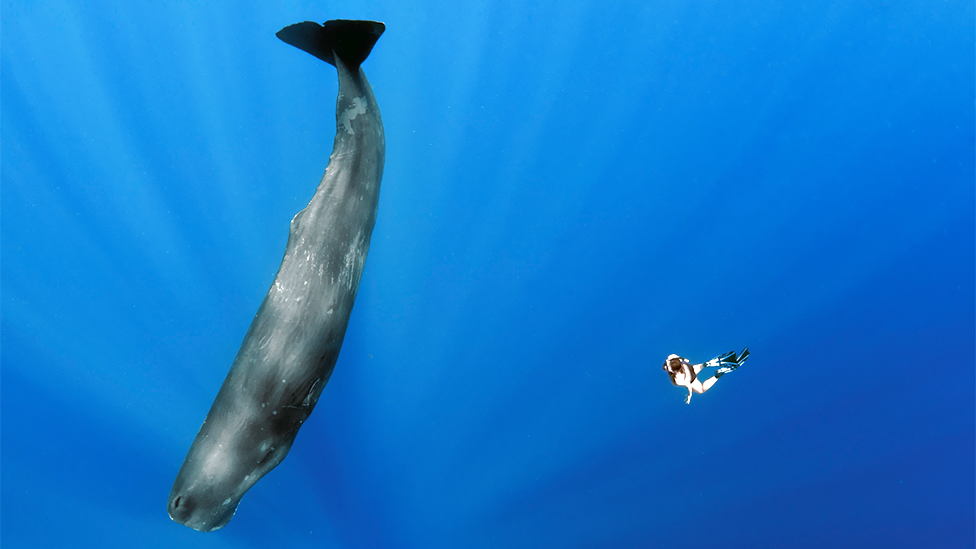
Sperm whales have been known to dive as deep equally 2000 metres beneath the surface in search of food. That'due south approximately two hours of breath-belongings. (Science Photo Library)
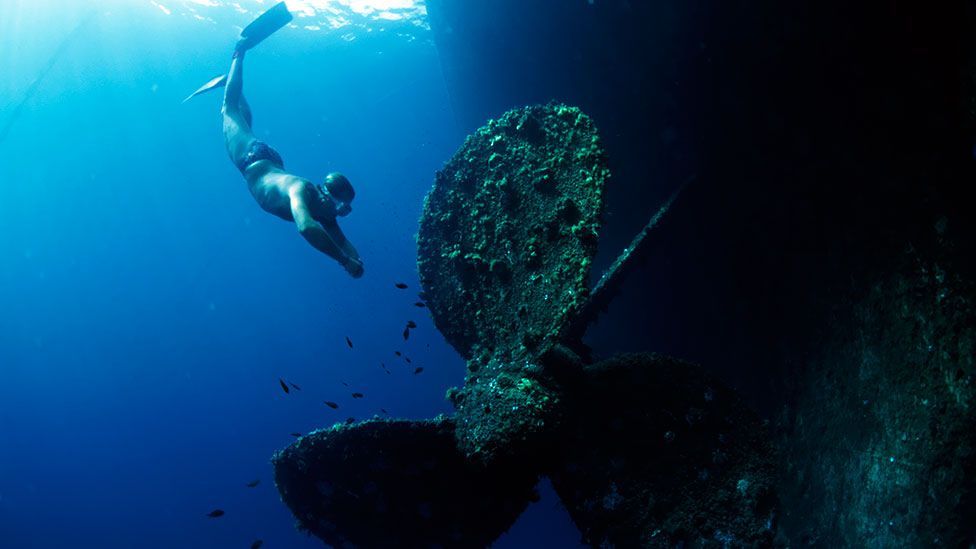
A diver approaches the wreck of a sunken send. Freediving has been used in underwater salve for thousands of years. (Scientific discipline Photo Library)
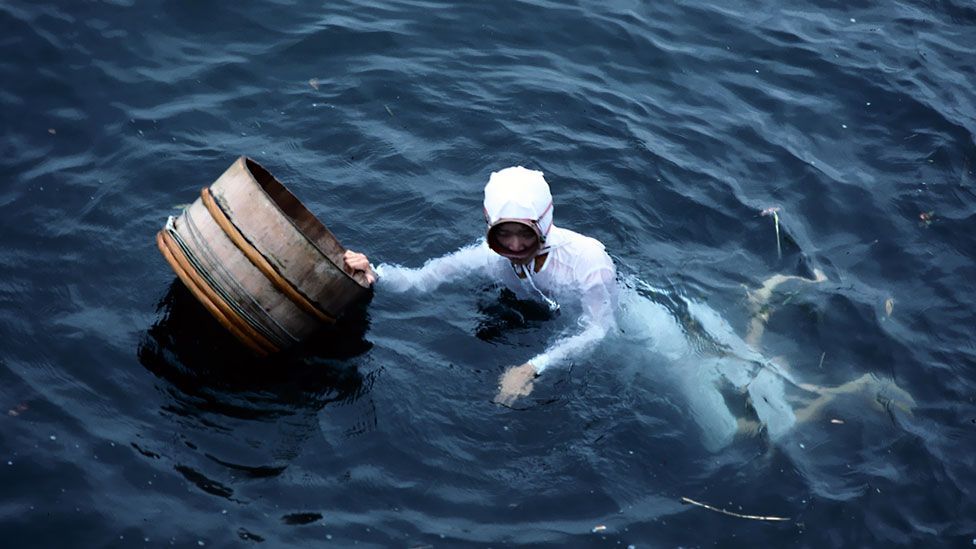
Pearl diving has been a feature of Japanese life for centuries. The 'ama' still do not utilize air tanks or scuba gear. (Science Photograph Library)
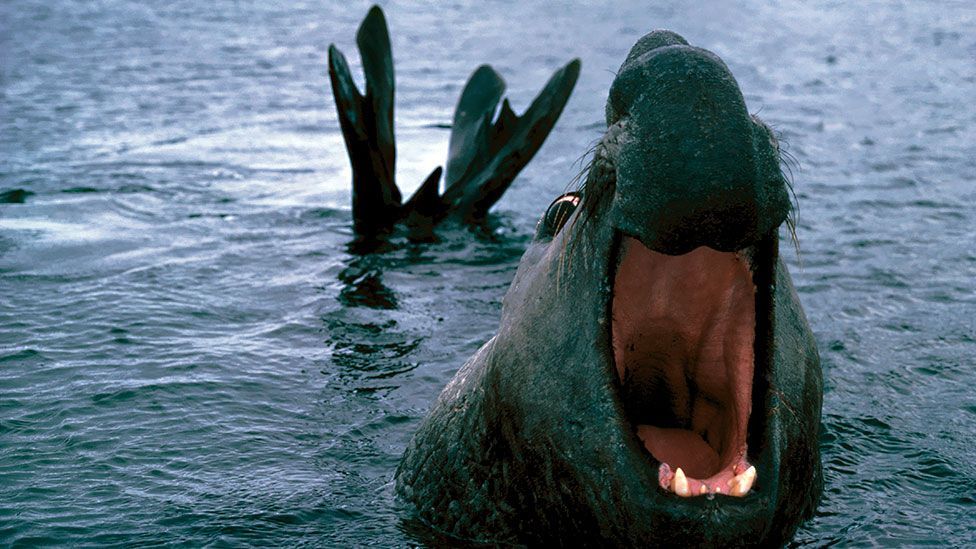
Some southern elephant seals can stay underwater for over two hours in search of fish or squid to eat. (Science Photo Library)

Pete Colat is a four-time record holder for jiff-holding (without swimming), preparing by animate pure oxygen for up to thirty minutes before submerging. (EPA/Ennio Leanza)
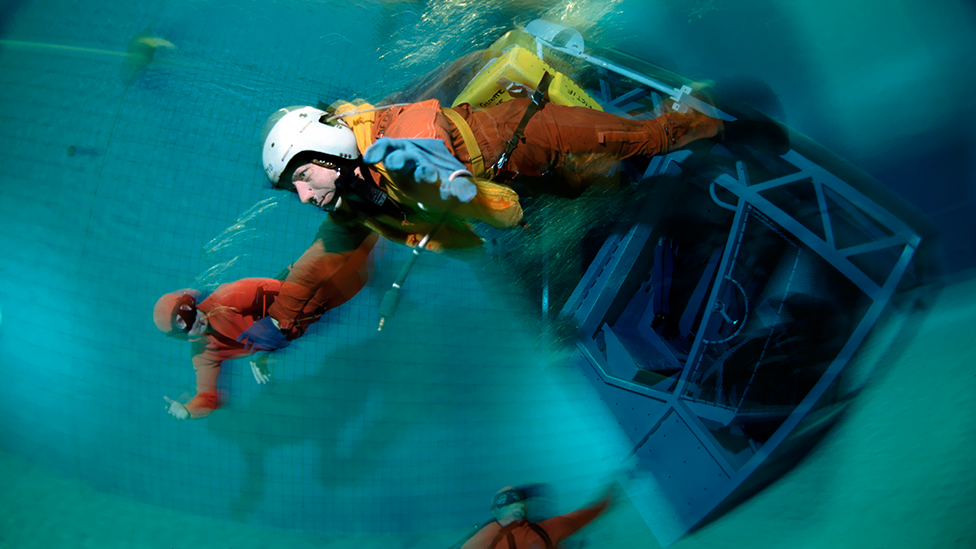
Jiff-holding is office of the training for some jobs: a airplane pilot practises escaping from a submerged shipping cockpit in Brest, France. (Science Photo Library)
Source: https://www.bbc.com/future/article/20140714-how-long-can-you-go-without-air
0 Response to "How Long Can I Go Without Taking a Shower"
Post a Comment